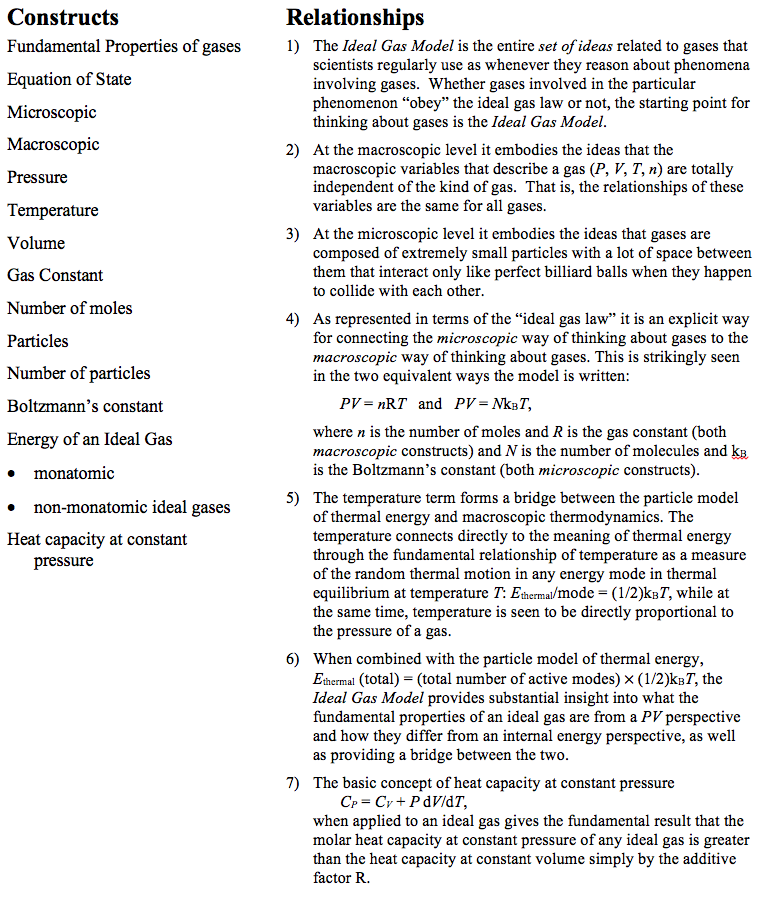Chapter 8.
Overview
Generality
Unlike solids and liquids, most gasses have many similar properties and behave similarly in many ways and circumstances. Whereas most physical properties of solids and liquids are unique to the particular solid or liquid, there is a tremendous similarity from one gas to another. The universal behavior of gases at the macroscopic level is captured in what is referred to as the ideal gas law, which gives the relationship among the pressure, temperature, and particle density of gases. This relationship is independent of the kind of gas and its chemical composition. For example, at room temperature and atmospheric pressure, all gases that are more than a few degrees above their boiling point, regardless of their molecular composition, are described by the same very simple relationship among pressure, particle density, and temperature. Consequently, at STP, we know that the average spacing of the particles is the same, regardless of the composition of the gas particles.
The same temperature that appears in the ideal gas law also provides the connection to the microscopic thermal properties of gases. By bringing together into this one gas model the relationships expressed in both the ideal gas law and the relationships from the particle model of thermal energy, we have the basis for a very general understanding, both qualitative and quantitative, of the behavior of gases.
Focus
Our focus is primarily on using both the macroscopic and microscopic relationships involving temperature to make sense of and answer questions about phenomena involving gases.
Model Summary

Representational Tools
Algebraic Representations
Ideal Gas Law:
kB = 1.381 x 10-23 J/K
R = 8.314 J / K·mol
Relationships that are connected by the thermodynamic temperature, T
PV = nRT and PV = N kBT
dU = TdS – PdV
Cv = dEth/dT
cpm = cvm + R (true only in the ideal gas model)
Ethermal/mode = ½kBT
Ethermal (total) = (total number of active modes) × ½kBT
Elaboration
Expanded Definitions of Model Constructs
Fundamental Properties of Gases
Many of the behaviors of gases at both the macroscopic and microscopic levels are surprisingly independent of the composition of the gas particles. There are a small number of fundamental properties responsible for this behavior.
Equation of State
An equation of state is a relationship among several macroscopic variables that constrains how they change as a substance is carried from one physical state to another during some process. The ideal gas law is an example of an equation of state that is simple to use and extremely powerful.
Macroscopic and Microscopic Variables Appearing in the Ideal Gas Law
8.314 J / K·mol. The constant used with the particle density is called the Boltzmann constant is has the value kB = 1.381 x 10-23 J/K. The gas constant is related to Boltzmann constant through Avogadro’s number, NA by R = NA kB.
Energy of an Ideal Gas
The molecules of a gas have both macroscopic and microscopic energies. The macroscopic energies are due to the translational motion of the molecules as they move through space. The microscopic energies are the thermal energies of any internal modes of the individual molecules that are active. See the Particle Model of Thermal Energy. Monatomic gas particles will not have any internal modes. Non-monatomic molecules will generally have rotational modes active at room temperature and perhaps have vibrational modes active at room temperature.
Heat Capacity at Constant Pressure
Heat capacities measured at constant pressure, as contrasted to those at constant volume, will involve doing work on the environment or container, since the volume will change. The heat capacity at constant pressure for an ideal gas will always be larger than the constant volume value.
Discussion of the Model Relationships
Relationship 7
The basic concept of heat capacity at constant pressure
when applied to an ideal gas gives the fundamental result that the molar heat capacity at constant pressure of any ideal gas is greater than the heat capacity at constant volume simply by the additive factor R.
We can directly calculate dV/dT from the equation of state for an ideal gas. Rearranging and differentiating PV = nRT (or for one mole, PV = RT), we get
dV/dT = R/P (remember P is constant)
Then, the expression for the molar heat capacity at constant pressure for an ideal gas becomes
cpm = cvm + R
For an ideal gas, the molar heat capacity at constant pressure is larger than at constant volume by exactly the value R. This is true for any ideal gas, whether monatomic, diatomic, or polyatomic, because the ideal gas law doesn’t depend on intra-atomic motions